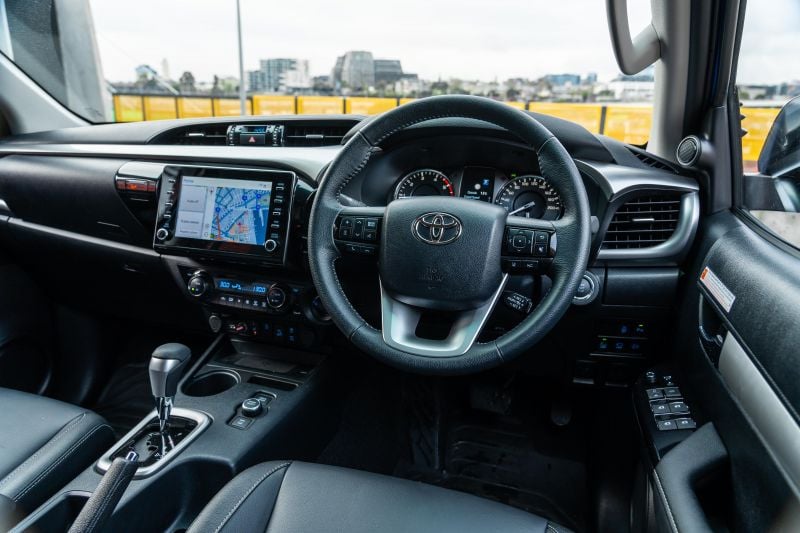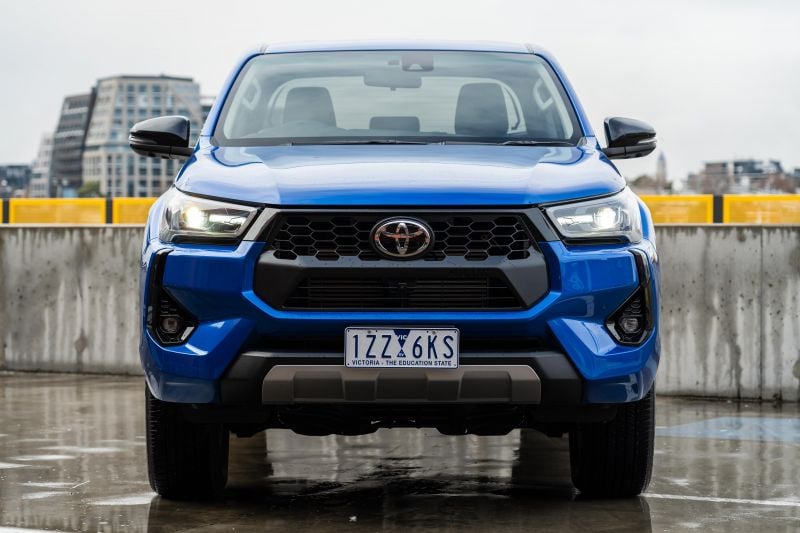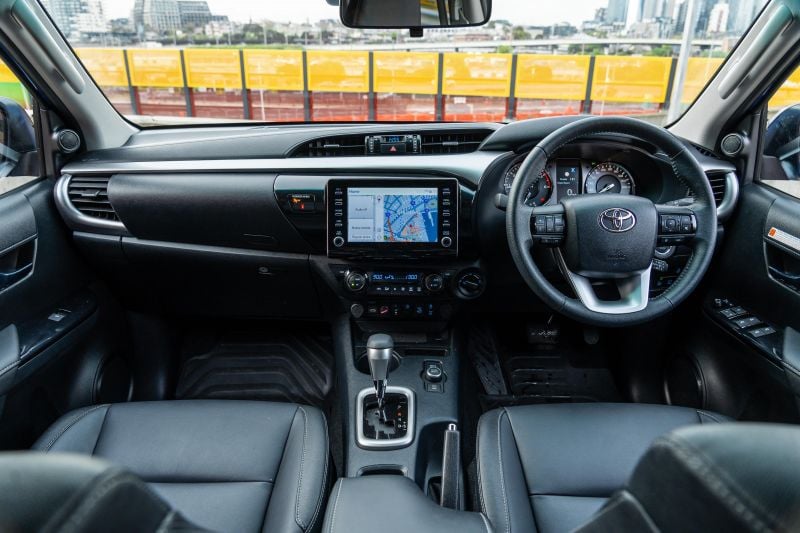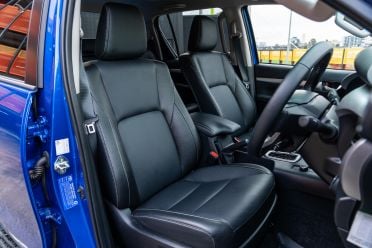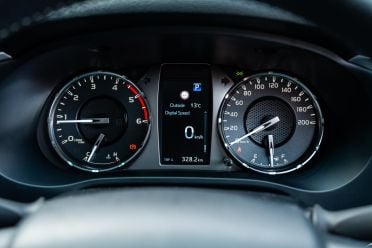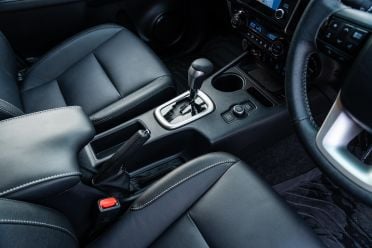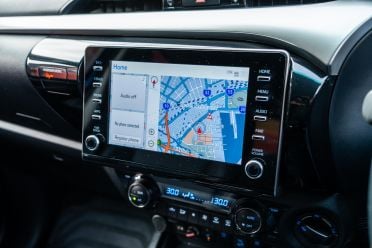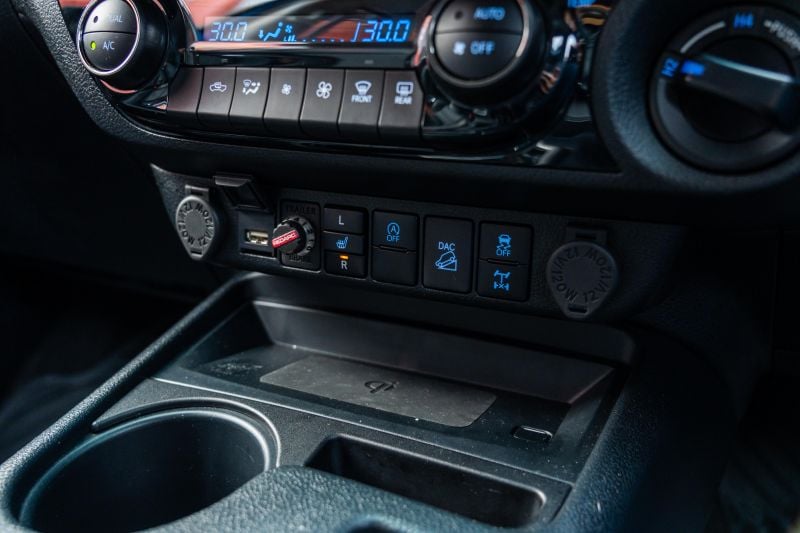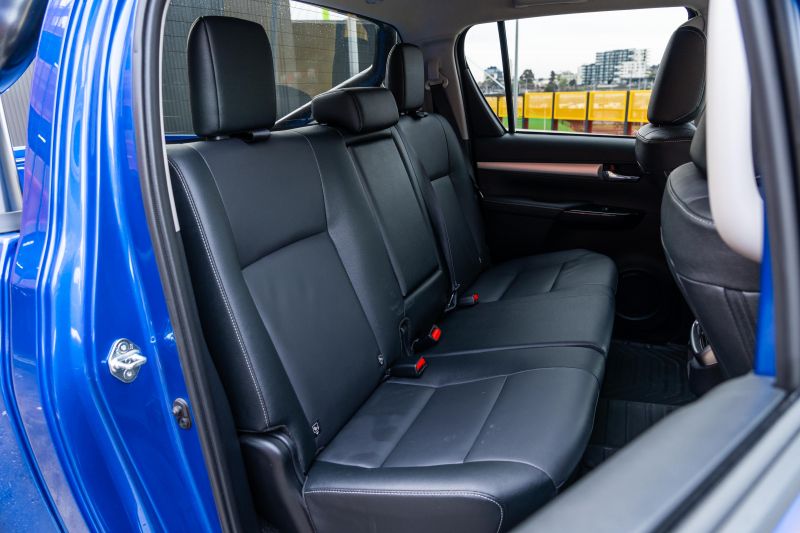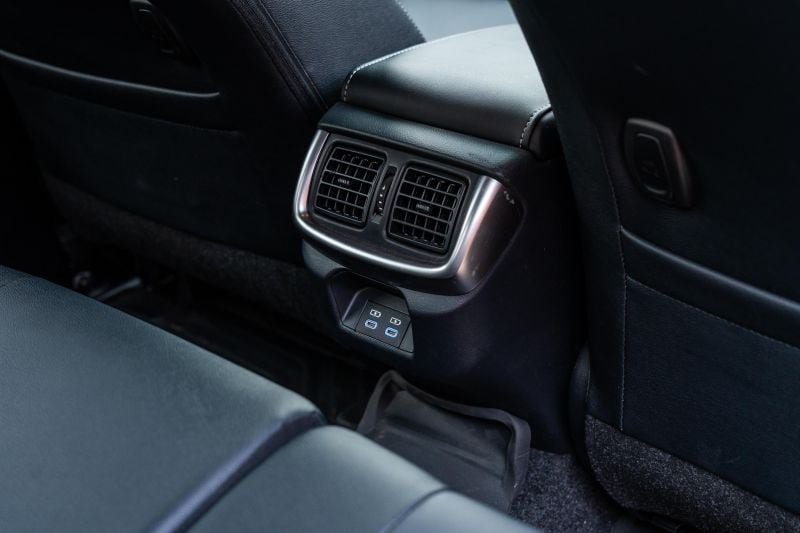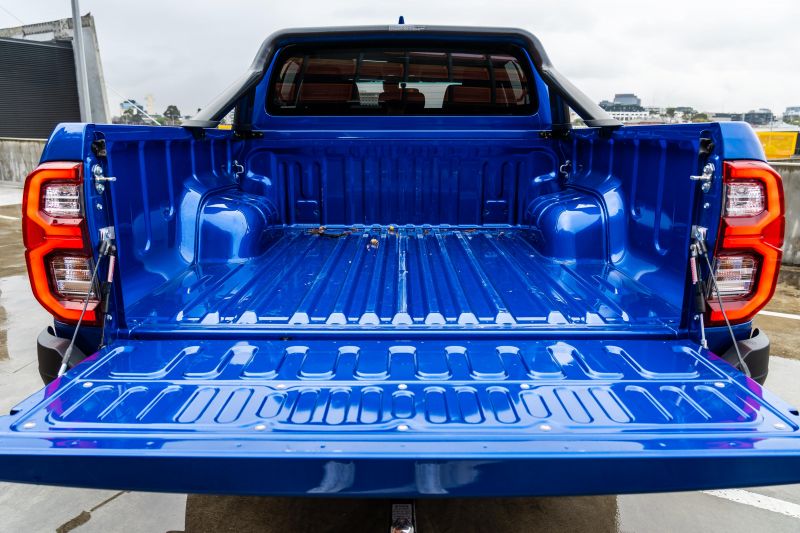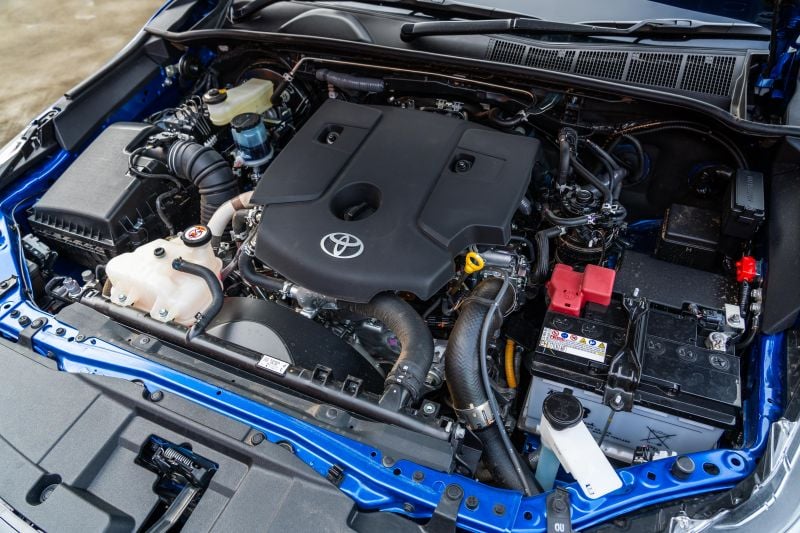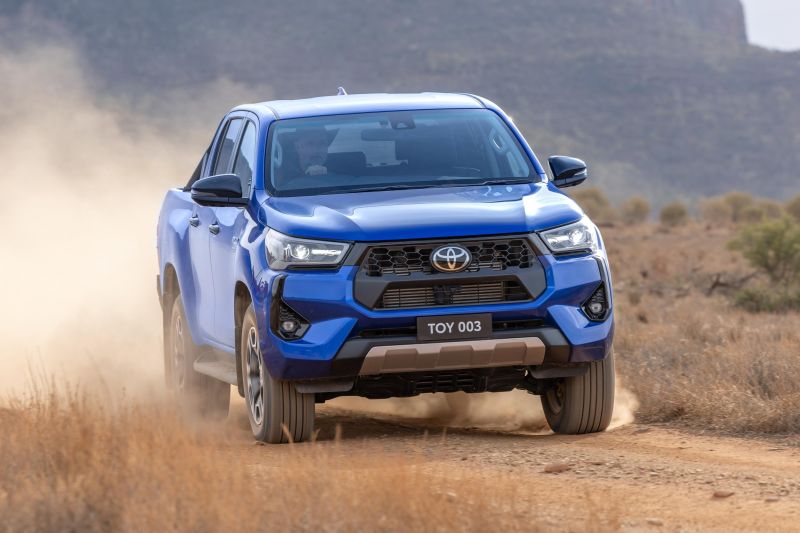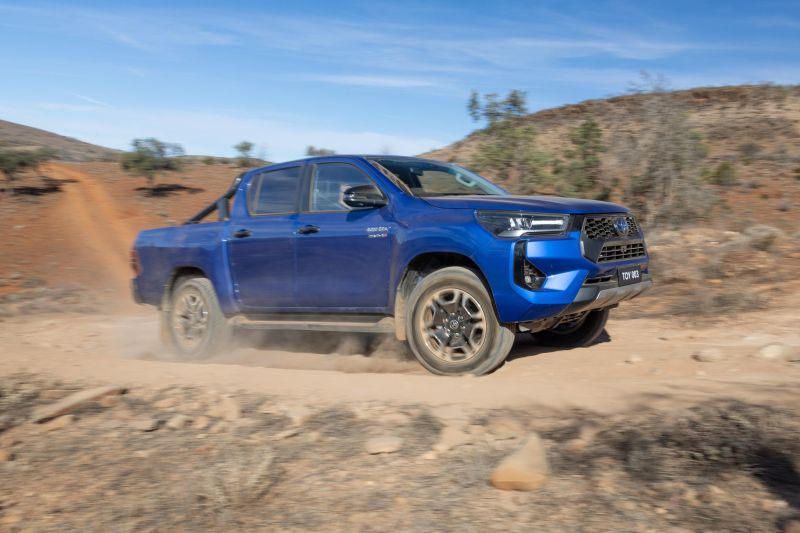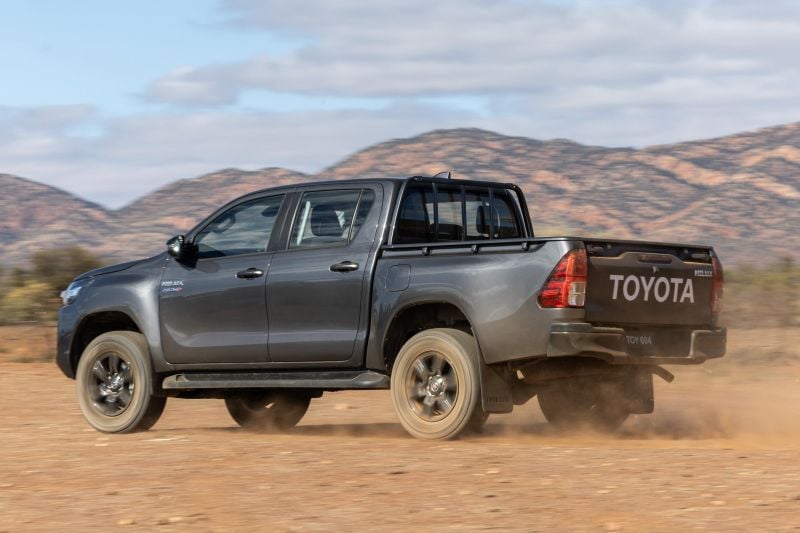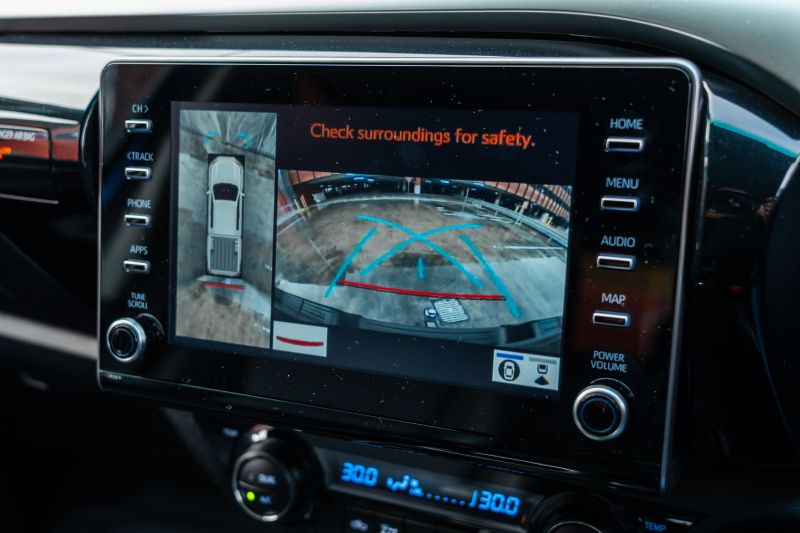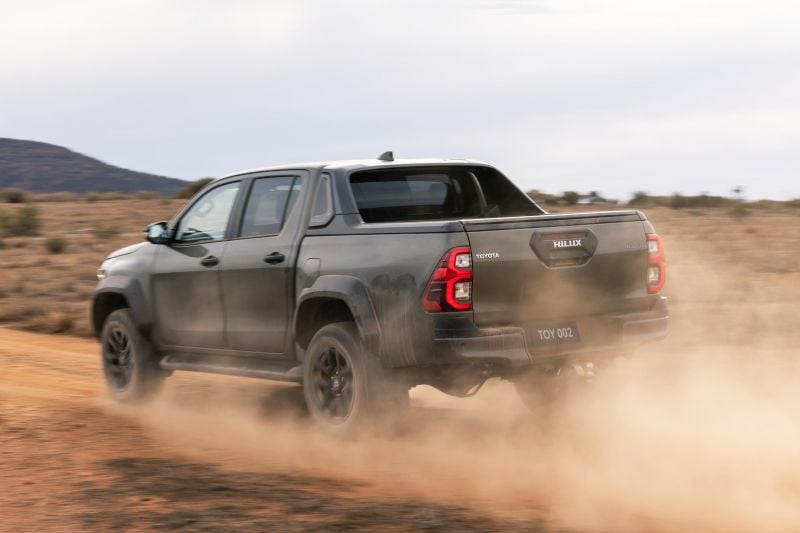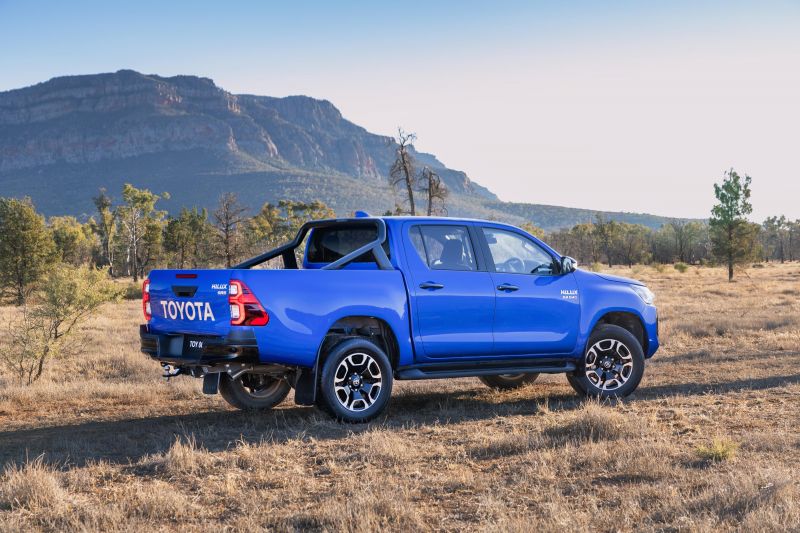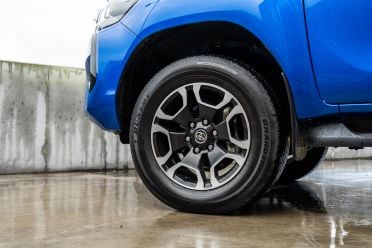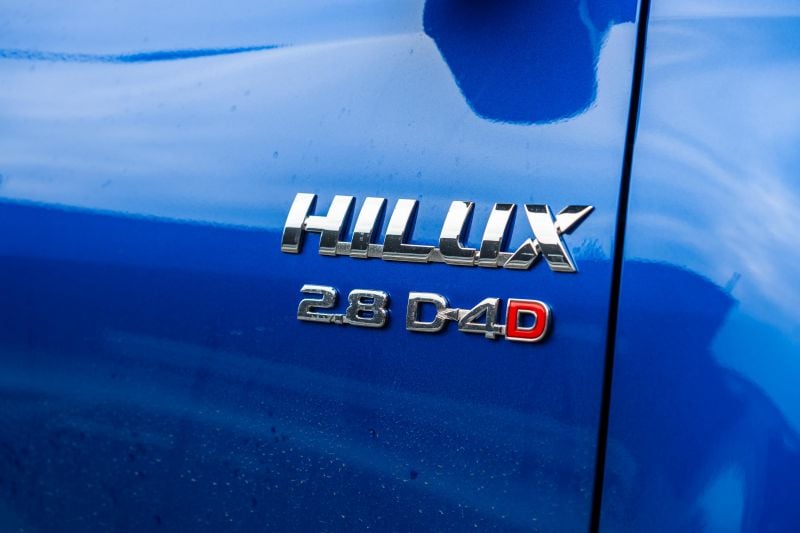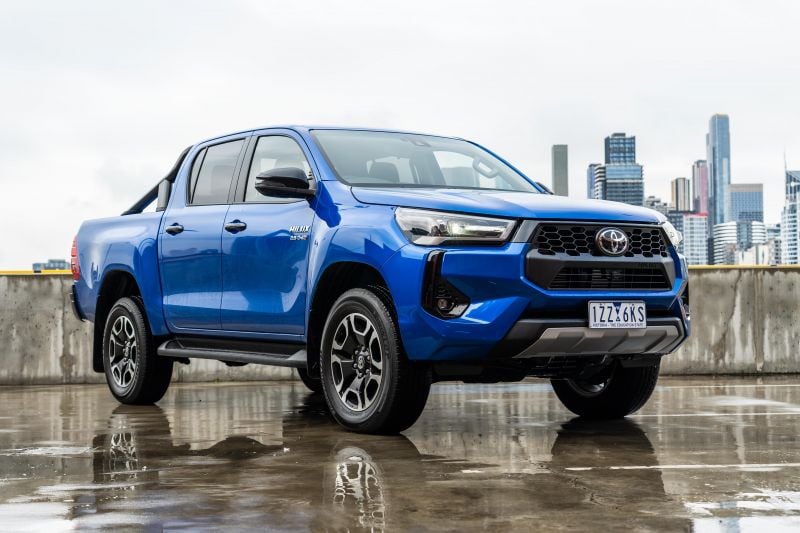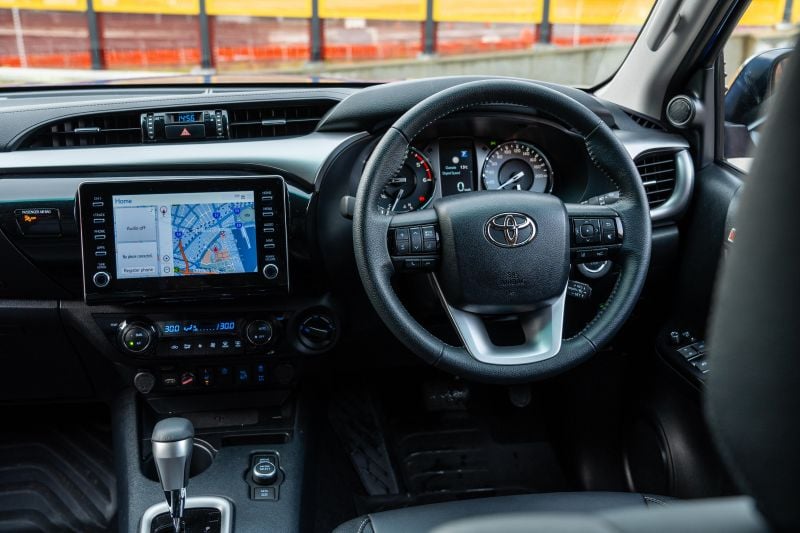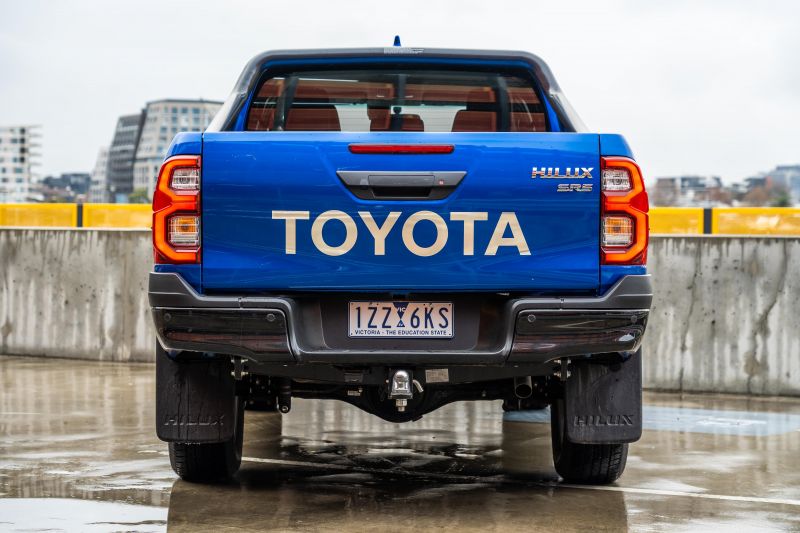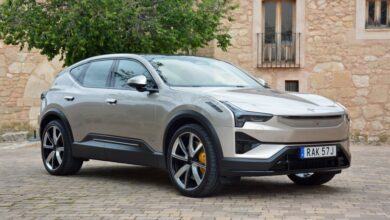2024 Toyota HiLux SR5 V-Active review
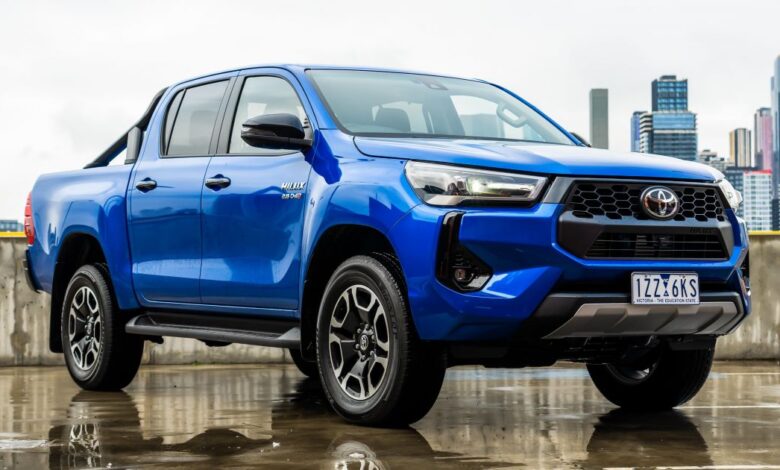
The Toyota HiLux with V-Active Technology – goodness that’s a mouthful…
Humour aside, this is a big deal for one of the current top-selling cars in Australia.
This Thai-built dual-cab ute now offers electrification for the first time ever, which is very timely given stricter new vehicles emission standards are just around the corner in Australia.
Power in this model still comes from the venerable 2.8-litre four-cylinder turbo-diesel but it’s now augmented by a 48V mild-hybrid system that comprises a belt-driven electric motor generator, small lithium-ion battery, and DC/DC converter.
Total system outputs are still 150kW and 500Nm, however the electric motor generator is capable of assisting acceleration and reducing the load of the turbo-diesel engine. Toyota claims this makes the HiLux more responsive, especially from standstill.
Fuel consumption in mild-hybrid variants is also claimed to be up to 9.5 per cent better, depending on variant. This is thanks in part to the inclusion of an engine idle stop-start system.
It’s worth noting if you’re wanting an automatic-equipped HiLux SR5 dual-cab, you’re now forced to get it with the new mild-hybrid V-Active Technology powertrain. The same goes for the lifestyle-oriented Rogue variant.
Outside the introduction of the new mild-hybrid turbo-diesel powertrain the HiLux has received a minor styling refresh on the outside and slightly more standard equipment.
In theory this new mild-hybrid powertrain has the greatest effect on fuel consumption in urban areas where heavy traffic is aplenty.
So in order to see how effective this system actually is, I put it to the ultimate test in ultra-heavy bumper-to-bumper Melbourne traffic.
Is it worth considering? Read along to find out.
How does the Toyota HiLux compare?
View a detailed breakdown of the Toyota HiLux against similarly sized vehicles.

Toyota
HiLux
How much does the Toyota HiLux cost?
The HiLux SR5 Double-Cab Pickup V-Active Technology is $770 more than the now-dead corresponding non-mild-hybrid automatic model.
| Model | Price before on-road costs |
|---|---|
| 2024 Toyota HiLux SR Double-Cab Cab-Chassis 4×4 V-Active Technology | $54,130 |
| 2024 Toyota HiLux SR Double-Cab Pickup 4×4 V-Active Technology | $56,210 |
| 2024 Toyota HiLux SR5 Double-Cab Cab-Chassis 4×4 V-Active Technology | $60,580 |
| 2024 Toyota HiLux SR5 Double-Cab Pickup 4×4 V-Active Technology | $63,260 |
| 2024 Toyota HiLux Rogue Double-Cab Pickup 4×4 V-Active Technology | $71,530 |
Our tester is also equipped with the Premium Interior option ($2000), as well as Nebula Blue metallic paint ($675) bringing the total asking price to $65,935 before on-roads, or $71,180 drive-away for Victorian buyers (each state has slightly different taxes).
To see how the Toyota HiLux lines up against the competition, check out our comparison tool.
What is the Toyota HiLux like on the inside?
Very much like it has been for a number of years now.
Hopping into the cabin of the HiLux SR5 is a little like stepping into a time machine and going back 10 years. In all fairness the current-generation HiLux does date back to 2015.
The SR5 is the highest-specified workhorse variant before you step up to the more lifestyle-oriented variants like the Rogue and GR Sport, so more durable, hard-wearing finishes are expected.
The high-traffic touch points in this car are admittedly soft, though there are plenty of harder plastics and finishes. One of the cheapest-feeling elements of the cabin is definitely the manual handbrake.
It’s a big step up into the HiLux. Even taller adults will likely need to use the side steps and chunky grab handles in order to hoist themselves in – this is a pretty common trait for high-riding utes.
Once you’re in you’re presented with some rather inoffensive-looking seats. Our tester is fitted with the Premium Interior package that adds leather-accented upholstery, heated front seats, and an electrically adjustable driver seat.
I personally wouldn’t opt for this pack if I was buying a HiLux SR5 as I like a ute to be as utilitarian as possible. I can see though if you’re a site foreman, for example, and spend a lot of time on the road why this would be a nice splurge to add to your mobile office.
The leather-accented driver’s seat itself does put the ‘lux’ in HiLux, though there are fancier-looking seats in other more comfort- and lifestyle-oriented utes. It’s a very comfortable seat for long-distance travel offering plenty of support and adjustment.
I particularly like how much thigh support you’re able to dial in as this helps make long-legged drivers feel more comfortable behind the wheel.
Speaking of the steering wheel, the HiLux SR5 has a leather-wrapped unit that feels very hardy and almost coarse. It certainly makes the ute feel utilitarian and like it will stand the test of time unlike softer leather-wrapped wheels in other utes.
All the buttons on the steering wheel are logically placed, though pushing and interacting with them isn’t very rewarding as they’re squidgy and doughy.
Behind the wheel is a very dated instrument cluster that comprises two physical dials for the revs and speed, as well as a 4.2-inch digital information display.
Thankfully the two physical dials are clear and easy to understand at a glance, though the digital information display is on the smaller side. Many other utes have a more sophisticated and technologically advanced instrument setup.
There are a few informative pages you’re able to cycle through on the digital information display, though there’s only one that displays a proper digital speedometer readout. A number of pop-ups for the adaptive cruise control and diesel particulate filter (DPF) burns also block the entire small display unless you clear them manually.
An informative page that’s unique to HiLux V-Active variants is one that displays the 48V lithium-ion battery charge and whether it’s charging from regenerative braking or assisting with acceleration. During my time with our tester this page’s content didn’t change at all, regardless of how I drove the ute.
Moving across there’s an archaic 8.0-inch touchscreen infotainment system that looks very old-school Toyota. Its resolution isn’t segment-leading but any means, but thankfully its reacts to touch inputs rather well.
The touchscreen infotainment system is nowhere near as polished and refined as newer Toyota infotainment systems, though it has a basic interface and is hard to get lost in. It’s also nice to have physical shortcut buttons in an age where these are disappearing from many cars.
The HiLux still has only the wired form of both Apple CarPlay and Android Auto through a USB-A port. The connection with my iPhone 15 Pro Max was generally fine, though I did have one occasion where Apple CarPlay came up but no audio would play through the speakers – unplugging and then replugging my phone fixed this problem.
There’s also built-in satellite navigation which is handy to have if you need to navigate home and don’t have phone service. It’s an easy-enough system to use but I much prefer using Google Maps on smartphone mirroring for the sake of simplicity.
Under the infotainment system I appreciate that Toyota has stuck with a proper climate control cluster that has physical dials and buttons. It’s much more intuitive than prodding at a touchscreen, especially if you’ve got gloves on.
At the front of the centre console there’s now a wireless phone charger in SR5 trim and up. It does look a little tacked on and there isn’t really anything to secure phones on the pad. Despite this my plus-sized phone charged on the wireless charger perfectly fine.
It’s worth noting that, given the HiLux still only offers wired smartphone mirroring, this does make the wireless charger somewhat redundant.
Another change to the centre console is the inclusion of a phone-sized slot that allows you to stow your phone somewhere that isn’t the wireless charger. My iPhone 15 Pro Max did stick a fair way out of the slot, almost obscuring the buttons for the heated seats. It’s a neat solution though.
Disappointingly there’s still only one proper cupholder on the centre console. Thankfully on the dash there are two retractable cupholders that are large enough to fit coffee cups.
The only other centre console storage nooks include a small rectangular space for keys or other odds and ends, as well as a centre armrest cubby with adequate storage and a cooling function.
Rounding out the storage spaces up front includes two glove boxes with decent storage, and door pockets with ample storage for bottles and other knick knacks.
Hopping into the second row of the HiLux is also a climb. Thankfully the big grab handles and side steps make this journey a lot easier.
Once you’re sat in the second row it feels a little confined, even by dual-cab ute standards. At a leggy 182cm I leg- and toe room were tight behind my own driving position, though head- and shoulder room were okay. There are roomier dual-cab utes out there.
While sat on an outboard second-row seat you do need to be mindful you don’t hit your head on the grab handle that juts out from the headliner. I know this from experience…
Two-up in the back of the HiLux is doable, especially for shorter adults or kids not in child seats, though pushing it to three makes things squishy.
Apprentices in the second row are treated to air vents mounted on the back of the centre console, two USB-C ports, as well as a fold-down armrest with cupholders.
It’s worth noting the 48V lithium-ion battery is located under the rear seats so there’s no storage space under there like in non-mild-hybrid dual-cab pickup variants.
This isn’t the end of the world because it’s often a forgotten storage cavity anyway.
At the back all HiLux pickup models now gain a tailgate damper that makes opening and closing the tailgate immensely easier. I can’t believe it has taken Toyota so long to include this as standard as it’s a very common aftermarket add-on.
Once the tailgate is open the HiLux SR5 has a pretty spartan tub layout. The only real amenity you get are a couple tie-down points. There’s not even a tub liner as standard so beware of scuffing items when loading and unloading.
The last thing I’ll mention is the HiLux’s tailgate is still not included in the central locking. Instead you’re required to lock the tailgate manually with a key. This is surprisingly pretty common for the segment.
| Dimensions | Toyota HiLux SR5 Dual-Cab Pickup V-Active Technology |
|---|---|
| Length | 5320mm |
| Width | 1855mm |
| Height | 1865mm |
| Wheelbase | 3085mm |
| Tub dimensions | 1570mm – length 1645mm – width 1109mm – between arches 481mm – height |
To see how the Toyota HiLux lines up against the competition, check out our comparison tool.
What’s under the bonnet?
If you want an automatic-equipped HiLux SR5 dual-cab you can now only get it with the new 48V mild-hybrid V-Active Technology turbo-diesel powertrain.
| Specifications | Toyota HiLux SR5 V-Active Technology |
|---|---|
| Engine | 2.8L 4cyl turbo-diesel |
| Hybrid | 48V mild-hybrid |
| Motor generator power | 8.4kW |
| Motor generator torque | 65Nm |
| Total system power | 150kW @ 300-3400rpm |
| Total system torque | 500Nm @ 1600-2800rpm |
| Transmission | 6-speed auto |
| Battery | 4.3Ah lithium-ion |
| Drive type | Part-time 4×4 |
| Fuel economy (claimed) | 7.2L/100km |
| Fuel economy (as tested) | 9.1L/100km (210km heavy urban traffic) |
| Fuel tank | 80 litres |
| Weight | 2150kg (kerb) |
| Payload | 900kg |
| Braked towing capacity | 3500kg |
| Gross vehicle mass (GVM) | 3050kg |
| Gross combination mass (GCM) | 5850kg |
Toyota claims you will see an 8.9 per cent improvement in fuel consumption with the SR5 V-Active Technology dual-cab pickup thanks to its 48V mild-hybrid system.
In previous testing of a non-mild-hybrid automatic HiLux SR5 dual-cab pickup I averaged approximately 10L/100km in similar but not identical conditions, which according to my basic math is around a 9.9 per cent fuel consumption improvement.
To see how the Toyota HiLux lines up against the competition, check out our comparison tool.
How does the Toyota HiLux drive?
Much like any other diesel-powered current-generation HiLux but with a very seamless, if occasionally temperamental, idle stop-start system.
This means the HiLux V-Active Technology shares both the best and worst attributes of the regular HiLux’s driving experience.
First up let’s discuss what is different. The biggest in V-Active Technology variants is the inclusion of a 48V mild-hybrid system which comprises an electric motor generator, 4.3Ah lithium-ion battery, and a DC/DC converter.
The electric motor generator is capable of producing up to 8.4kW and 65Nm though it never solely powers the wheels, hence why Toyota Australia has avoided labelling this ute as a hybrid.
It can however assist the turbo-diesel engine when accelerating, which according to testing of a HiLux Rogue V-Active Technology by CarExpert founder Paul Maric earlier this year actually made the dual-cab ute faster from 0-100km/h.
By the seat of my pants overall performance doesn’t feel earth-shatteringly different from the non-mild-hybrid equivalent in everyday driving. Initial takeoff does feel ever so slightly faster but that’s about it.
With this in mind the 48V mild-hybrid system in the HiLux V-Active Technology can essentially be viewed as a glorified engine idle stop-start system that can help to reduce tailpipe emissions when stationary.
What I noticed, like many mild-hybrid vehicles, the HiLux V-Active Technology’s turbo-diesel engine will very happily switch off at a standstill. It doesn’t even need to warm up that much in order to do so, which is very reassuring.
While the engine idle stop-start system was very active for me, a number of my colleagues couldn’t get the system to activate at all. This could be due to a number of different factors including the set climate control temperature/fan speed, 48V battery charge level, and even how much braking pressure was being applied when stationary.
There were only a few times the engine idle stop-start system wouldn’t activate for me. The majority of which was due to the climate control as it has been FREEZING in Melbourne recently. I do appreciate how the digital information screen tells you the reason why the engine didn’t turn off at a standstill or is starting back up.
When the start-stop system is activated in ideal situations the engine will stay off for a considerable amount of time. There were times I was sat so long the engine would fire up and then turn off again a minute or so later.
Speaking of the engine restarting, it uses the electric motor generator rather than a typical starter motor. What this means is when you take your foot of the brake pedal the engine just seamlessly fires back to life. It’s a bizarre sensation, especially when I’m so used to hearing the classic Toyota starter motor sound.
The HiLux V-Active’s start-stop system is actually a rather good setup in the city that’s much more comprehensive than less sophisticated systems in it other utes. Though for many people it’s the first thing they turn off when hopping in, which completely negates its benefits.
Something worth noting is if you frequently drive the mild-hybrid HiLux out on the open road, you’re likely not experiencing the same level of fuel-saving benefits compared to driving in the city as the turbo-diesel engine never switches off on the move.
If all this sounds a little bit too high-tech, don’t fret as all the HiLux’s fundamentals have stayed the same. The 2.8-litre turbo-diesel engine still has the same chugging sound which can be little gruff when compared to its rivals.
As mentioned above, there’s no real noticeable difference when it comes to everyday performance of the HiLux V-Active. If driven with docile throttle inputs the ute can be very smooth, though if you’re a little more liberal with the beans it can get loud, thrashy and sometimes a little clunky.
All mild-hybrid HiLux variants come with a six-speed automatic transmission that feels heavy duty in terms of its operation. The ratios are rather long which means acceleration can sometimes feel a bit CVT-like which isn’t the most thrilling.
I also noticed depending on my throttle application there can be some awkward lurches and surging between gears every now and then. It’s almost like the transmission is switching from normal to overdrive gearing.
A frustrating element that hasn’t changed about the HiLux is its hydraulic steering system. It’s one of the last vehicles in its segment to still have this old-school setup, as plenty of its rivals have now moved to more sophisticated electric power-assisted steering systems.
The HiLux’s hydraulic power-steering system makes driving the ute a handful at the best of times, with the steering feeling very heavy at lower speeds. Even at higher speeds you need to input near constant minor steering adjustments and corrections which makes it tricky to get comfortable and relaxed behind the wheel.
If you’re parking this 5.3-metre long beast be prepared for a lot of wheel twirling. The huge turning circle also means there will likely be plenty of three-point turns in tight carparks.
Speaking of parking, the HiLux SR5 pickup comes with front and rear parking sensors, as well as a surround-view camera. The latter of which has one the lowest-resolution camera setups I’ve experienced in a modern vehicle. For this price point the HiLux deserves a lot better.
Another major gripe I have about the current HiLux is its unladen ride. Its one of the hardest and unrelenting setups compared to its key rivals.
Honestly at times the ride is as rough as guts and you feel every single road imperfection which send hard jolting movements into the cabin. While singing in the ute it also gave me some unwanted vibrato.
Putting people in the HiLux and a load in the back does noticeably settle the ride down, however. It’s clear the HiLux SR5 is workhorse-oriented and not comfort-oriented like other lifestyle-focussed dual-cab utes.
This flows onto how the HiLux’s ladder-frame chassis limits its dynamic abilities. Its rather rigid and bouncy, and when you push the ute that bit harder in the bends it tends to get a lot of body roll.
Out on the open road the HiLux’s turbo-diesel engine hits a nice sweet spot. At 100km/h the revs sit comfortably around 1500rpm and will willingly flare in needed.
Although the engine is at ease, with both the fidgety steering setup and rough ride the HiLux can tiring to drive for long periods of time at higher speeds. There are considerably more comfortable dual-cab options out there.
On the safety front, the HiLux still only comes with high-speed adaptive cruise control. This means is the system requires you to take over control of the acceleration and braking at city speeds, unlike virtually all of its key rivals.
The hydraulic power steering system also limits the amount of active assists the HiLux can receive. In addition to the lane departure warning that beeps at you for drifting close to a lane marking however, there’s only a brake-based lane-keep assist.
The latter of these systems can be a little harsh as it slows the car down a tad. It can also get easily confused on wet roads where the lane markings are hard to see.
I didn’t get to test out the off-road capabilities of the HiLux SR5 V-Active this time in particular, but over the non-mild-hybrid equivalent it gains Multi-Terrain Select modes that are only available in four-high (4H) and four-low (4L) on unsealed surfaces.
During his testing of the HiLux Rogue V-Active earlier this year, Paul Maric found the Multi-Terrain Select modes do noticeably alter the throttle and traction control calibrations. He also wished the functions were available in two-wheel drive.
Lastly, Mr Maric noted the 48V mild-hybrid system with its belt-driven motor generator isn’t affected from light off-roading as its reinforced to ensure no slippage.
| Off-road dimensions | Toyota HiLux SR5 V-Active Technology |
|---|---|
| Track front and rear | 1535mm, 1550mm |
| Ground clearance | 216mm |
| Approach angle | 29 degrees |
| Departure angle | 27 degrees |
| Wading depth | 700mm |
To see how the Toyota HiLux lines up against the competition, check out our comparison tool.
What do you get?
On test here is the mid-spec HiLux SR5 V-Active Technology Dual-Cab Pickup with the Premium Interior package.
2024 Toyota HiLux SR V-Active Technology highlights:
- Multi-Terrain Select with six selectable modes
- Hill descent control
- Front and rear parking sensors
- Side steps
- 17-inch alloy wheels
- Automatic headlights
- 8.0-inch touchscreen infotainment system
- Wired Android Auto and Apple CarPlay
- 6-speaker sound system
- Cloth upholstery
- Dual-zone climate control
- Auto up/down windows
- Keyless entry and start
- Front air-conditioned cooler box
SR5 V-Active Technology adds:
- Dark-finish LED headlights
- Gloss black exterior mirrors and door handles
- Powder-coated black sports bar
- 18-inch alloy wheels
- Privacy glass
- Satellite navigation
- DAB+ digital radio
- Rear air vents
- ‘Premium’ shifter and steering wheel
- Wireless phone charger
- 2 x rear USB-C outlets
- Carpeted floors
- Blind-spot monitoring (pickup only)
- Rear cross-traffic alert (pickup only)
- Surround-view camera (pickup only)
Premium Interior package ($2500) adds:
- Leather-accented upholstery
- Heated front seats
- Power driver’s seat
Premium paint is also a $675 option.
Is the Toyota HiLux safe?
The Toyota HiLux has a five-star ANCAP safety rating based on testing conducted in 2019 – this applies to V-Active variants also.
| Category | Toyota HiLux |
|---|---|
| Adult occupant protection | 36.7 out of 38 (96 per cent) |
| Child occupant protection | 42.6 out of 49 (87 per cent) |
| Vulnerable road user protection | 42.3 out of 48 (88 per cent) |
| Safety assist | 10.2 out of 13 (78 per cent) |
Standard safety equipment includes:
- Autonomous emergency braking
- Pedestrian (day/night) detection
- Cyclist (day) detection
- High-speed adaptive cruise control
- Lane departure warning
- Brake-based lane assist
- Traffic sign recognition
Pickup models gain front and rear parking sensors, while SR5 and up get blind-spot monitoring, a surround-view camera and rear cross-traffic alert.
All HiLux variants also come with three years of complimentary access to Toyota Connected Services. Functions include SOS emergency call, automatic collision notification, stolen vehicle tracking, and use of the myToyota Connect phone app.
How much does the Toyota HiLux cost to run?
The Toyota HiLux is covered by a five-year, unlimited-kilometre warranty like the wider Toyota lineup.
If you service through the Toyota dealer network properly however this warranty can be extended to seven years as long as the vehicle isn’t used for commercial purposes.
| Running costs | Toyota HiLux V-Active Technology |
|---|---|
| Warranty | 5 years, unlimited kilometres – standard 7 years, unlimited kilometres – extended 5 years, unlimited kilometres – 48V battery (standard) 7 years, unlimited kilometres – perforation (rust through panel) 1 year, 20,000km – utility deck panels (paint/surface rust) 2 years, unlimited kilometres – 12V battery |
| Roadside assistance | $99 per year |
| Service intervals | 6 months or 10,000km |
| Capped-price servicing | 3 years |
| Capped-price service cost | $290 per service |
| Total capped-price service cost | $1740 |
CarExpert’s Take on the Toyota HiLux
The mild-hybrid Toyota HiLux is a great step in the right direction when it comes to reducing urban fuel consumption and tailpipe emissions.
It’s certainly no series-parallel hybrid or plug-in hybrid, but depending on how and where you drive the HiLux V-Active Technology you’ll likely end up saving fuel thanks to the mild-hybrid system, even if it is incremental.
Obviously the most fuel-saving benefits of the mild-hybrid system are reaped if you spend a lot of your time in heavy city traffic and are stationary.
If the conditions are right the engine idle stop-start system definitely puts the active in V-Active Technology. It’s one of the best start-stop systems in a ute out there to date as it’s very smooth and seamless to live with.
Despite this I can still see a lot of people turning off the system as it can potentially be viewed as intrusive or annoying – though this negates its purpose which is frustrating.
Beyond this the HiLux is still largely the same which means it still has the same gripes.
These include the rough unladen ride, heavy hydraulic steering, lack of more sophisticated driver assists, old interior technology, and no full-time four-wheel drive system, among others.
Put bluntly, there are plenty of other utes out there more comfortable, easier to drive long distances in, and have similar fuel consumption figures.
With this is mind I’d definitely recommend giving other utes a test drive before signing on the dotted line to ensure the HiLux V-Active Technology is for you.
Click the images for the full gallery
MORE: Buy a Toyota HiLux
MORE: Everything Toyota HiLux

